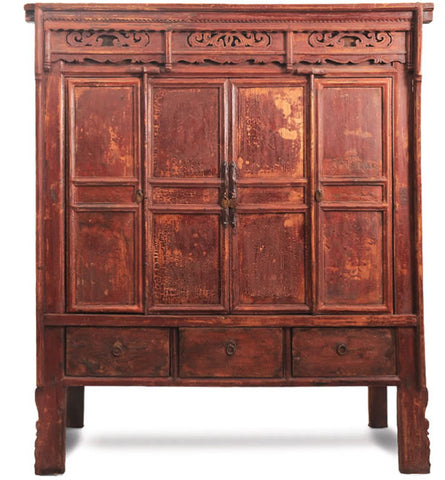
Collecting Chinese furniture
Fans of Chinese antiques will have spotted some of the more unusual pieces in the latest additions to the Shimu website.
All our antiques are sourced from China by Shimu Director James Cottrell, who makes regular trips to Beijing and Shanghai. Occasionally, he finds some absolute showstoppers, which as well as looking amazing in any home, we would expect to increase in value due to their rarity.
|
For example, the extraordinary family shrine on the right dates from 1750 and is in wonderful condition, the beautiful hand carved decoration on the upper panels still intact along with the delicate carved panels on the doors. The ornate upper carvings are of flowers, while above the sloping roof are Buddhist symbols flanked at each end with a dragon. The once bright colours are now in a softer palette of reds, browns and blues. This is a beautifully made, quite rare piece of Chinese history, and extremely well preserved. Not everyone has the space or the budget for an antique shrine, but how about this imposing yet practical elm cabinet, dating from 1770? It would once have been used in a temple in the central Chinese province of Shanxi. It has some beautiful, intricate carving on the panels above the four doors and carved front feet. |
 |
 |
The four doors are panelled, set within rounded frames and mounted into the cabinet on wooden dowels. The cabinet is still in its original lacquer finish. This would once have been a more vibrant red, but has worn and faded over the years to a more subtle reddish brown with a wonderful crackled patina. This is a rare and unusual piece and with its impressive proportions the cabinet would provide a huge amount of storage space. It’s pieces like these which we hope could make a wise investment. It’s becoming harder and harder to source Chinese antiques in original condition, meaning prices are always going up. |
Hardwood furniture from China has been a big thing for the past decade, with some yoke-back armchairs and screens bringing top prices at auction. However, many pieces are fakes. About 30% of the furniture sold as “antique” in Hong Kong, for instance, is new furniture made to look old. The remainder has been restored to various degrees.
If you’re interested in finding out more about collecting Chinese antiques, why not make an appointment with Shimu Director James Cottrell, who can discuss what pieces might be right for you? Simply email to set up a meeting.





Comments
Leave a comment